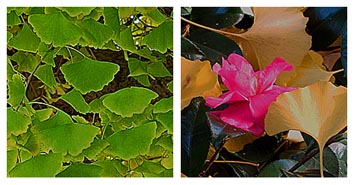
| 「いちょう」 11月、東京もようやく紅葉の季節である。 東京の街には、桜と欅が多くて、美しく紅葉する。しかし、何といっても、紅葉の主役は、「もみじ」と「いちょう」である。 「もみじ」は、樹形的に街路樹・並木に向かないせいか、庭園・造園、いわゆる、植木である。しかし、もちろん、山林に多種多様の種が自生している。「いちょう」は、作庭には不向きで、街路樹・並木あるいは、公園・庭園内の独立樹とされる。 「いちょう」は、実に興味深い樹木である。 1億年以上昔の化石が出土しているくせに、今,我々と共に地球上に現存しているのは、単独種、一種のみである。現在、世界中に自然林はなく、すべて、植林され人の手をかけて保存してきた。ということは、さしずめ数千年も前から、ずっと、・レッドリスト上の絶滅危惧種・(定義によっては、絶滅種)だったわけだ。 となると、原産地・最後の自然林はどこなのだろうかという興味がわいてくる。物の本・資料・論文、全ては、中国・安徽省あたりだろうと言っている。しかし、私は、この学会的定説は怪しいと思う。 何故ならば、中国語には、「いちょう」という樹木を意味する単漢字がない。世界で飛び離れた人口を有する中国は、表音文字を使わない唯一の国でもある。3000年以上の昔から中国では、森羅万象、あらゆる事象の一つ一つの定義づけが為される度に、一つの漢字を創作して来た。この基本原理を彼らは「一字一音一義」と称び、最重要の文化資産・誇りとしている。漢字二つで一語の事象は、中国から見て異国の物といって、ほぼ、常に正しい。 つまり、「いちょう」を示す単漢字がない、ということは、中国では、大昔から、「いちょう」を他国産・異文化移入の樹木と見做して来たということに他ならない。外観・実用性・長寿・・・あらゆる意味で、これほど特色・特異性のある樹木が、中国の文化史上、単に見過ごされて来たとは、考えられない。「いちょう」は、銀杏を食べるだけではない。建材・造作材としても優秀で、我国の料亭厨房で用いられる最高の俎板(まないた)は、「いちょう」の板である。ドイツでは、いちょうの葉エキスは医薬品として認可されている。 「いちょう」は、英語で何と言いますか? 「乙女のあそこの毛 maiden hair tree」です。 東京には、いちょうの葉をマークにしているところがいくつもありますね。 Ginkgo November is the season of colored autumn leaves even in warm Tokyo. In the inner city of Tokyo, there are many cherry trees and keyaki (Zelkova serrata / a sort of elm?). Their autumn leaves are beautiful. But autumn leaves of maple trees and ginkgo trees are so bright and representative in Tokyo urban area. Maple trees do not quite fit to line the streets so usually they are planted in gardens. In the nature there are many different sorts of maple trees in the mountain forests giving fantastic nuances of autumn colors. Ginkgo has strong profile and so characteristic that does not applied in the Japanese gardens. But ginkgo is often planted in the parks and along the streets, making fine lines. Ginkgo is a very interesting tree. The fossils of ginkgo were found from many different places and they are 120,000,000 years old. But the gingkoes we see today are only one species. There is no neighboring species. There is no natural forest of ginkgo. We see many ginkgoes in the world and all of them are panted and kept by the people. It may be considered that gingkoes have been an endangered species or already an extinct species on the Red List for thousands of years. Then, where is the place of origin of ginkgo? Where could be the last natural forest of gingko? In the most of the academic materials it is stated the origin of ginkgo was somewhere south eastern area in China, Anhui or Zhejiang. But I doubt it. Why do I doubt it? Because a word with one character meaning gingko does not exist in the chinese language. China is the largest nation in the world. The population of China is 1,360,000,000. (USA; 315,000,000.) And China is an only nation using only ideograms, Chinese characters. Chinese characters are not phonograms, not phonetic letters. We Japanese use Chinese characters together with kana that is phonograms. Chinese characters were made some 3000 years ago. Everything, concrete or abstract, has a corresponding symbol, Chinese character. “One letter, one sound, and one definition” this is a very strict firm principle which Chinese people have kept when they found a new phenomenon and made a new character. A thing named using two characters suggests the thing is a stranger for China. Therefore, there is no one single character meaning ginkgo proves the tree gingko has been considered by Chinese people strange and imported. The tree gingko has such very characteristic form and is useful material as timber and used to live very long, often longer than 1000 years. It would never happen the tree has not have just neglected in the Chinese cultural history. Gingko plank is valued as highest material for cutting board by Japanese chefs. Gingko leaves extract is medicine in Germany. Do you know gingko’s common English name? It is “Maiden hair tree”. You can find many gingko leaf marks in Tokyo! |
| TOP |